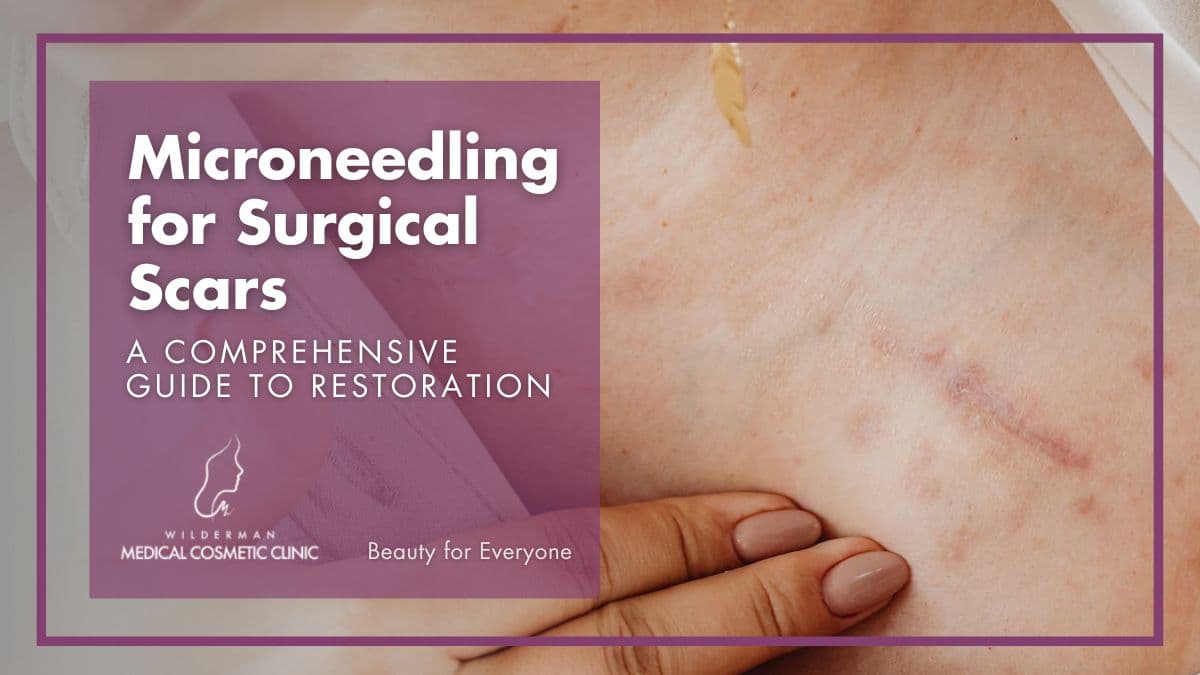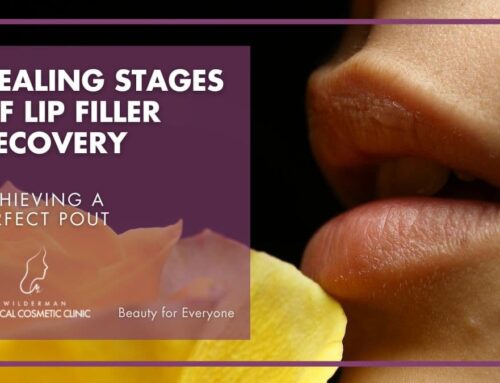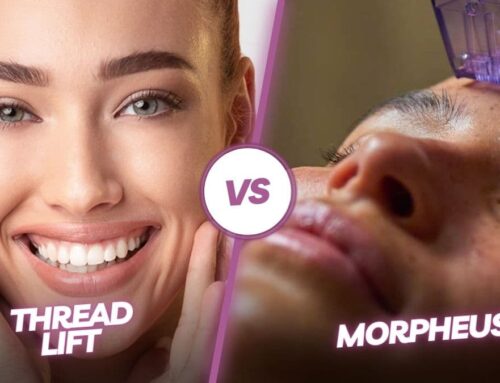Microneedling for Surgical Scars
A Comprehensive Guide to Restoration
Surgical scars, whether from elective procedures or necessary interventions, often leave lasting marks on the skin. While these scars may tell a story of resilience and healing, many individuals seek ways to minimize their appearance. Microneedling, a minimally invasive cosmetic procedure, has gained popularity as an effective method for improving the appearance of surgical scars.
Various studies “support the use of microneedling for various facial and nonfacial scars across a broad range of skin phototypes with minimal risk of adverse effects.”

Get immediate answers to your questions about treatment options, costs, expected outcomes, and more.
- Expert Diagnosis
- Customized Treatment Plans
- No Obligation
- Comfort and Privacy
- Immediate Answers
How does Microneedling work?
Microneedling, also known as collagen induction therapy, is a minimally invasive cosmetic procedure that involves the use of a device with fine needles to create controlled micro-injuries on the skin’s surface.
The procedure stimulates the body’s natural wound-healing process, leading to the production of new collagen and elastin fibers, which are crucial for maintaining skin elasticity and texture.
Here’s a step-by-step breakdown of how microneedling works:
Micro-Injuries: During the microneedling procedure, a specialized device equipped with fine, sterile needles is gently rolled or stamped over the skin’s surface. The needles create microscopic punctures, or micro-injuries, in the skin.
Stimulating the Healing Response: The micro-injuries triggered by microneedling are perceived by the body as superficial wounds. In response to these controlled injuries, the body initiates a natural healing process.
Collagen and Elastin Production: As part of the healing process, the body starts producing new collagen and elastin. Collagen is a structural protein that provides firmness and strength to the skin, while elastin enhances skin elasticity.
Tissue Remodeling: The newly formed collagen and elastin fibers work to repair the micro-injuries, leading to the remodeling of the skin tissue. This process helps to reduce the appearance of scars, wrinkles, fine lines, and other skin imperfections.
Improved Blood Circulation: Microneedling also promotes increased blood flow to the treated area. Improved blood circulation brings essential nutrients and oxygen to the skin, contributing to its overall health and vitality.
What type of scars benefit from microneedling?
Microneedling is a versatile and effective treatment for various types of scars, helping to improve their appearance by stimulating the body’s natural healing processes.
The types of scars that can benefit from microneedling include:
Acne Scars
- Boxcar Scars: Broad, depressed scars with well-defined edges.
- Rolling Scars: Indented scars with a rolling or undulating appearance.
- Icepick Scars: Deep, narrow scars resembling small puncture marks.
Surgical Scars
- Hypertrophic Scars: Raised scars resulting from excessive collagen production during the healing process.
- Atrophic Scars: Depressed scars are often seen after surgical procedures.
Traumatic Scars:
- Keloid Scars: Raised, overgrown scars extending beyond the original wound site.
- Contracture Scars: Tight, potentially limiting movement due to the skin’s contraction during healing.
Burn Scars:
- Hypertrophic Burn Scars: Raised scars resulting from burns that can be improved with microneedling.
Stretch Marks:
- Striae Distensae: Microneedling may help improve the appearance of stretch marks by stimulating collagen and elastin production.
Chickenpox Scars:
- Atrophic Pockmarks: Indented scars left by severe chickenpox lesions.
Does it work on both old and new scars?
Yes, microneedling can be effective on both old and new scars, making it a versatile option for individuals seeking to improve the appearance of various types of scars.
The efficacy of microneedling on scars, regardless of their age, is primarily attributed to the stimulation of the body’s natural wound-healing response and the subsequent production of collagen and elastin.
Microneedling on New Scars:
Enhanced Healing: In the case of new scars, microneedling can expedite the healing process. The controlled micro-injuries created by the fine needles stimulate the release of growth factors and cytokines, promoting the formation of new blood vessels and accelerating tissue repair.
Prevention of Excessive Scar Formation: By initiating a balanced and controlled healing response, microneedling can help prevent the excessive production of collagen, which often leads to hypertrophic or keloid scarring.
Improved Texture and Appearance: Early intervention with microneedling on new scars can contribute to a smoother and more aesthetically pleasing texture as the collagen fibers align in a more organized and natural manner during the healing process.
Microneedling on Old Scars:
Collagen Remodeling: For older scars, microneedling becomes a powerful tool for collagen remodeling. The micro-injuries created by the needles stimulate the production of new collagen and elastin, which can gradually replace the old scar tissue with healthier, more elastic skin.
Softening and Flattening: Over a series of microneedling sessions, the procedure can soften and flatten the appearance of raised scars, such as hypertrophic scars or keloids. The improved collagen structure helps to create a more uniform skin surface.
Enhanced Penetration of Topical Treatments: The micro-channels created by the needles during microneedling also enhance the penetration of topical treatments, allowing for better absorption of scar-reducing creams, serums, or other therapeutic agents.
How much improvement can you expect?
It’s important to note that while microneedling is generally effective for various types of scars, individual responses may vary. The degree of improvement depends on factors such as the type and severity of the scar, the patient’s skin type, and their overall health. Additionally, multiple sessions may be required to achieve optimal results.
Consulting with a qualified skincare professional is crucial to determine the suitability of microneedling for a specific type of scar. They can assess your individual case, recommend a personalized treatment plan, and provide information on the expected outcomes and any potential risks associated with the procedure.
Combining microneedling with other complementary treatments may also be considered to enhance overall results.
What other complementary treatments can be used in conjunction with microneedling to enhance the appearance of scars?
Several complementary treatments can be combined with microneedling to enhance the appearance of scars. Here are some of them:
Laser Therapy:
How it Works: Laser treatments use focused light energy to target pigmentation irregularities and stimulate collagen production.
Enhancement with Microneedling: Combining laser therapy with microneedling can provide a comprehensive approach to scar reduction, addressing both surface imperfections and underlying collagen remodeling.
Topical Treatments:
How they Work: Topical treatments, such as vitamin C serums, retinoids, and silicone-based creams, can contribute to scar reduction by promoting collagen synthesis, reducing inflammation, and improving skin texture.
Enhancement with Microneedling: Microneedling creates micro-channels in the skin, allowing topical treatments to penetrate more effectively. The combination enhances the absorption of active ingredients, potentially improving scar appearance.
Dermal Fillers:
How they Work: Dermal fillers contain substances like hyaluronic acid that add volume to depressed scars, helping to raise and level the skin surface.
Enhancement with Microneedling: Microneedling can complement dermal filler treatments by improving overall skin texture and promoting collagen production, creating a more natural and harmonious result.
Platelet-Rich Plasma (PRP):
How it Works: PRP involves using the patient’s own concentrated platelets to stimulate tissue regeneration and collagen production.
Enhancement with Microneedling: Microneedling creates microchannels for better PRP absorption, amplifying the healing effects. The combination can enhance overall skin rejuvenation and scar improvement.
Chemical Peels:
How they Work: Chemical peels involve applying a chemical solution to exfoliate the skin’s top layer, promoting cell turnover and improving pigmentation.
Enhancement with Microneedling: Combining microneedling with a chemical peel can enhance the exfoliation process and stimulate collagen production, contributing to improved scar texture and color.
It’s crucial to note that the suitability of these complementary treatments depends on factors such as the type of scar, skin type, and individual health considerations. Consulting with a qualified skincare professional is essential to create a personalized treatment plan tailored to your specific needs and ensure the safety and effectiveness of the combined treatments.
Lifestyle tips for preventing/improving the appearance of scars
In addition to professional treatments like microneedling and complementary therapies, adopting certain lifestyle practices can contribute significantly to preventing and improving the appearance of scars.
Here are some lifestyle tips to consider:
Sun Protection:
Tip: Shield scars from direct sunlight to prevent hyperpigmentation and worsening of scars.
How to Implement: Use sunscreen with a high SPF on scars when exposed to the sun, and consider protective clothing.
Healthy Diet:
Tip: Consume a nutrient-rich diet to support overall skin health and the body’s natural healing processes.
How to Implement: Include fruits, vegetables, lean proteins, and foods rich in vitamins A, C, and E, which play crucial roles in skin health.
Hydration:
Tip: Keep the skin well-moisturized to enhance its elasticity and promote healing.
How to Implement: Drink an adequate amount of water daily and use moisturizers to prevent dryness.
Avoid Smoking:
Tip: Quit smoking, as it can impair the body’s natural healing processes and negatively impact skin health.
How to Implement: Seek support, such as counseling or nicotine replacement therapy, to quit smoking.
Gentle Cleansing:
Tip: Cleanse scars gently to avoid irritation and promote a healthy healing environment.
How to Implement: Use mild, fragrance-free cleansers and avoid abrasive scrubbing on the scarred area.
Regular Exercise:
Tip: Engage in regular physical activity to improve blood circulation and overall skin health.
How to Implement: Incorporate aerobic exercises and activities that promote blood flow to the skin.
Scar Massage:
Tip: Perform gentle scar massage to promote tissue flexibility and prevent adhesions.
How to Implement: Use a moisturizer or scar gel and gently massage the scar in circular motions.
Stress Management:
Tip: Manage stress levels, as chronic stress can potentially impact the body’s healing processes.
How to Implement: Practice relaxation techniques such as meditation, deep breathing, or yoga.
Avoid Picking or Scratching:
Tip: Resist the urge to pick at or scratch scars, as this can impede the healing process and lead to further damage.
How to Implement: Keep the scar clean, and covered, and resist the temptation to touch or scratch it.
Consult with Skincare Professionals:
Tip: Seek professional advice for scar care and adhere to post-treatment instructions.
How to Implement: Consult with skincare professionals to develop a personalized scar management plan.
Remember, consistent and holistic care, including both professional treatments and lifestyle practices, can contribute to better scar outcomes.
Takeaway
The road to scar improvement involves a mix of professional treatments, complementary therapies, and smart lifestyle choices. Microneedling is a key player, aiding different types of old and new scars by kickstarting the body’s natural healing and collagen production.
Adding laser therapy, topicals, dermal fillers, platelet-rich plasma, and chemical peels to microneedling can enhance results. Yet, practical steps matter too. Guarding against the sun, a balanced diet, hydration, quitting smoking, gentle scar care, exercise, and stress management all contribute to a scar-friendly environment.
Remember, professional advice is crucial. Skincare experts can tailor treatments and guide you towards healthier, more confident skin. In this holistic approach, combining microneedling, complementary therapies, and lifestyle tweaks ensures a well-rounded strategy for scar improvement and self-assurance.
Reference
Alster TS, Li MKY. Microneedling of Scars: A Large Prospective Study with Long-Term Follow-Up. PlastReconstr Surg. 2020 Feb;145(2):358-364. doi: 10.1097/PRS.0000000000006462. Erratum in: PlastReconstr Surg. 2020 May;145(5):1341. PMID: 31985622.
Singh A, Yadav S. Microneedling: Advances and widening horizons. Indian Dermatol Online J. 2016 Jul-Aug;7(4):244-54. doi: 10.4103/2229-5178.185468. PMID: 27559496; PMCID: PMC4976400.
DeRosa Clinic. (n.d.). What Type of Scars Can Be Improved with Microneedling. DeRosa Clinic Blog. Retrieved from https://derosaclinic.com/blog/what-type-of-scars-can-be-improved-with-microneedling
American Academy of Dermatology. (n.d.). Microneedling: How to fade scars. AAD – American Academy of Dermatology. Retrieved from https://www.aad.org/public/cosmetic/scars-stretch-marks/microneedling-fade-scars
Healthline. (n.d.). Microneedling for Acne Scars. Healthline. Retrieved from https://www.healthline.com/health/microneedling-for-acne-scars
Microneedling: Insights and Key Information
Personalized Microneedling Solutions at Thornhill’s Wilderman Cosmetic Clinic: Your Path to Flawless Skin
What is Microneedling? Minimally invasive skin treatment using fine needles for rejuvenation – Microneedling is a minimally invasive cosmetic procedure designed to improve the texture, tone, and overall appearance of the skin. During microneedling, a device …
Microneedling Recovery: Healing Stages – Microneedling, also known as collagen induction therapy, is a minimally invasive cosmetic procedure that involves using tiny needles to create controlled micro-injuries on the skin’s surface. This process stimulates …
Microneedling for Acne Scars: Benefits, Treatment, Risks, Results – Acne scars can leave a lasting impact on one’s self-esteem and confidence. Countless individuals struggle to find effective treatments that can diminish the appearance of these scars.
Microneedling for Burns: A Promising Treatment for Scar Reduction – Burn injuries can be not only physically painful but also emotionally distressing, often leaving lasting scars that serve as a constant reminder of the trauma. While there are various treatments available, microneedling has …
Microneedling vs. Laser Skin Resurfacing: Pros, Cons, and Takeaway – In the quest for radiant, youthful skin, microneedling and laser skin resurfacing have emerged as two popular options. Both treatments aim to address a wide range of skin concerns, from wrinkles and fine lines to …
Stay Ahead of the Beauty Curve
Beyond Beauty: Elevate Your Routine with Insider Tips and Breakthroughs – Subscribe Now!
Transform your beauty routine into something extraordinary!






